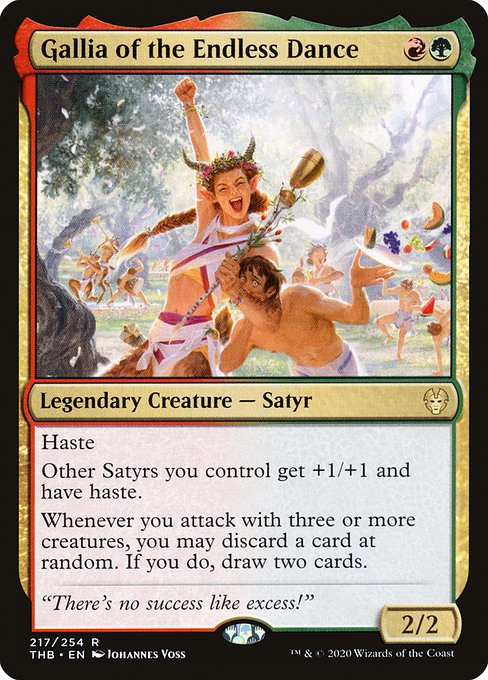Magic is a game about two things: combat and inevitability. There’s not a lot of joy in inevitability though. Satisfaction, certainly, and sometimes pleasure—but knowing that things must end, even if you’re unsure how, tends to dilute joy. Therefore, most of the “joy” in Magic has to be found in combat—in the joy of the berserker, the self-effacing ecstasy of life and death struggle.
That makes sense, as there’s a carnal connotation to the word “joy”—its etymology is in the Latin “gaudia,” meaning a pleasure or sensual delight, as contrasted to more exalted forms of happiness—and it’s best embodied by Gallia of the Endless Dance. I love Johannes Voss’s art, from the spotlight-stealing “banana satyr” in the background to the distorted, almost freakish joy on Gallia’s face. As a strictly PG-13 game, Magic has to abandon (or mostly abandon) the sexual aspects of ecstatic revelry; satyrical joy in Greek and Roman myth, of course, was deeply connected to sexuality and to abandonment of social mores in service of all kinds of fulfillment.

But what works so well about Gallia, and the savage joy seen in Theros, is the physicality—Gallia expresses her joy via headlocks and carpe diem card draw. It’s the joy of cats choke-slamming and rabbit-kicking each other, the joy of siblings piledriving each other in the shallow end, the joy that violently overflows the heart and is too large for words to express. It’s the same kind of joy that the Cult of Rakdos embraces, albeit to a fault.
Gallia is a case study in Wizards’ creative decision to add nuance to Red’s color identity. Rather than the color of “rage and fury,” Red is becoming the color of passion and inspiration. Red, as in Gallia, may sacrifice long-term plans for short-term benefits, and it may break more than it creates, but it still yearns to create. Red is postmodernist—it’s a reaction to the mandated structures that it doesn’t itself subscribe to, but must still be confined and defined by. Red reacts, but Red doesn’t have to react impulsively or destructively. Fire destroys cities, but it also warms homes. I love this softening of red, the embrace of the hearth as well as the forge, and I love how it’s expressed in cards like Thrill of Possibility, Rix Maadi Reveler, and Heartwarming Reunion. There’s a subtle assertion in those sacrifices that says one day all of this work will be worth it—you may have to give something up in the short-term, but you’ll have more opportunities in the long run (or you’ll just reanimate a terrifying threat). It’s a commentary on the dignity of work and on the necessary sacrifices individuals make to give themselves future opportunities.

Contrast Gallia to Theros’ other Gruul card: Klothys, God of Destiny. “Destiny” is an odd concept to include within Red’s credo; it implies a lack of free will, but an endpoint doesn’t define an entire life. We know our destiny: it’s to die. But Red understands that not every choice made leads to that destiny. Red wants freedom, not free will. Red doesn’t care where it ends up, but how it felt as it made the journey.
What cards in recent history—since Mark Rosewater’s last explication of the color’s philosophy—embody Red’s newfound joy? , I’m discounting cards like Bonecrusher Giant and Glorybringer—they’re mechanically Red, but they don’t have much of a commentary behind them beyond “large, undercosted, and damage-dealing.” I’ve spoken about Cathartic Reunion before, as it was the forerunner of this trend—a revisitation of Red’s emotional nature, and how it can hit emotions beyond rage and revelry. Cathartic Reunion still requires a sacrifice—sometimes, joy hurts in its enormousness—but it rewards you.
Light Up the Stage is a study in how to do Red right. It requires a metacost—planning ahead to deal damage to turn on the Spectacle cost—that’s easily met by the color’s main goals. And it lets Red have access to card advantage without disrupting Red’s impulsive attitude. Fires of Invention is another big one—anyone who’s dropped a Fires can tell you the joy they felt at casting it—and it represents a truly interesting restriction for Red’s creativity: a monomaniacal focus. Mechanically, the two spells per turn keeps Fires from cascading into an absurd chain of spells, but textually, it feels like someone burning the candle at both ends. They’ve hit a threshold of knowledge and expertise that allows them to skip the tedium of gathering resources, but there are still only so many hours in the day.
It may just be a false cognate, but “Theros” is awfully close to the ancient Greek “therion,” meaning “wild beast.” Theros is an ordered world—all the gods in their pantheon, all the dead in their demesnes—but there’s space for wildness, too. In Ravnica, random wurm attacks and demonic revels are to be periodically expected, but remarkable. Theros, meanwhile, is universally perilous—serpents in the seas and hydras in the forests and catoblepases in the swamps. Even death isn’t a respite. It’s a wild world, but more than that, it’s a Red world, full of creativity and intercessions from fickle gods and brave warriors snatching victory from the jaws of defeat or a Cerberus. There’s triumph in its struggles, but more than that, there’s joy.
A lifelong resident of the Carolinas and a graduate of the University of North Carolina, Rob has played Magic since he picked a Darkling Stalker up off the soccer field at summer camp. He works for nonprofits as an educational strategies developer and, in his off-hours, enjoys writing fiction, playing games, and exploring new beers.

